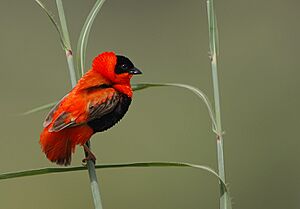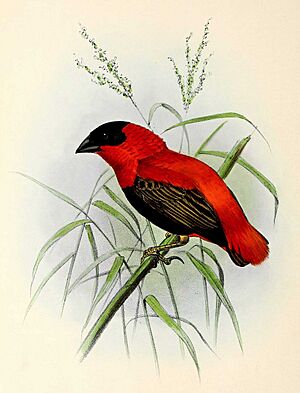Northern red bishop facts for kids
Quick facts for kids Northern red bishop |
|
|---|---|
 |
|
| Male in breeding plumage | |
 |
|
| Breeding male in Gambia | |
| Conservation status | |
| Scientific classification | |
| Genus: |
Euplectes
|
| Species: |
franciscanus
|
| Synonyms | |
|
Euplectes franciscana |
|
The northern red bishop or orange bishop (Euplectes franciscanus) is a small passerine bird. It belongs to the Ploceidae family, which includes weavers and bishops. This bird is part of the largest group in its family, with over 60 different species. Its closest relative is the Southern red bishop (Euplectes orix).
You can easily spot this bird by the bright reddish-orange and black feathers of the male during breeding season. It is most common in northern Africa. However, people have also brought it to parts of the western world.
Contents
About the Northern Red Bishop
The northern red bishop was first described in 1789 by Paul Erdmann Isert in Ghana, Africa. The name Euplectes means "good weaver." The word franciscanus refers to the Franciscans, a religious group from the 12th century. Their robes were a deep crimson color, like the bird's feathers.
The northern red bishop used to be considered a type of its neighbor, the southern red bishop (Euplectes orix). But now, scientists see them as two different species. The equator separates them. The northern red bishop lives in northern Africa, while the southern red bishop lives in the south. You can tell the northern red bishop apart because the male has a continuous red color under its chin.
Its closest relative, besides the southern red bishop, is the black bishop (Euplectes gierowii). This bird also lives in Africa. There are no known different types (subspecies) of the northern red bishop.
What Does the Northern Red Bishop Look Like?
This small bird has a short tail. It is about 11 cm (4.3 inches) long and weighs about 12-22 grams (0.4-0.8 ounces). Its bright red-orange feathers get their color from special pigments. These pigments come from compounds in the bird's diet.
Specifically, yellow, orange, and red colors come from compounds called carotenoids. These are very important for the bird's diet. Two main carotenoids, lutein and two red parts (R1 and R2) from lutein, give the bird its color in the wild. Northern red bishops kept in zoos or as pets might not have the R2 red part in their diet.
The male's bright feathers cover its back, chin, throat, and chest. It has a dark black crown, forehead, and belly. Its tail and upper wings are brown. It has pale legs and a black beak.
Only breeding males have these striking colors. Females and non-breeding males look different. They have dull brown and white feathers, similar to a song sparrow. When breeding season starts, males change into their bright feathers. After the breeding season, they lose these bright feathers and look more like the females again.
Where Do Northern Red Bishops Live?
The northern red bishop lives in many parts of northern Africa. You can find this bird in countries like northern Liberia, southern Mauritania, Senegambia, Guinea, and Ethiopia. They also live in Sudan, Tanzania, and Kenya, among others.
Northern red bishops usually live in tall grasslands. They also like cultivated areas near water and marshes. These birds have been seen in lowlands and at high places, up to 1000 meters (about 3,280 feet).
This bird was brought to Puerto Rico in the 1960s. Since then, it has been seen throughout the West Indies. It has been reported in Martinique, Guadeloupe, Barbados, and Jamaica. It has also been seen in Cuba and St. Croix, U.S. Virgin Islands.
In recent years, northern red bishops were also brought to parts of the United States. This includes southern California, Texas, and Hawaii. In 1997, about 400 northern red bishops lived in Los Angeles and Orange counties in California. This number might have gone down because some marshland habitats have been lost. A small group also lives in Harris County, TX.
Behavior and Life Cycle
Reproduction
Male northern red bishops are larger than females. This species also practices polygyny, meaning one male mates with several females. Males use their bright feathers and special displays to attract mates. The bright orange-to-yellow feathers with black parts are very important for attracting females.
During breeding season, the male's song is quite simple and doesn't change much. Males might not even sing when it's not breeding season.
Males often mate with up to six females. They use their bright feathers to fly in special ways to attract females. They also puff out their body feathers. Once a female lands, the male builds a round nest for her. The female then lines the nest for her future chicks.
The brightest males who build the best nests and have good territories (with lots of food) tend to have more babies. This means that having vibrant feathers and good nesting spots is very important for males. Females do all the parental care for their young. This includes sitting on the eggs to keep them warm and feeding the chicks. Males do not care for or feed their offspring.
Nests are usually made from different grasses and reeds. They are placed within the marshy plants. The number of eggs laid in Africa is not fully known. However, in South Africa, the related southern red bishop usually lays 2 to 3 eggs. The chicks stay in the nest for about 14-16 days.
Breeding seasons can start as early as May and end as late as November. They last between 2 and 6 months. This depends on when the rainy season begins and ends, which is usually from November to March. In California, northern red bishops usually lay 2–3 eggs. The breeding season there is from August, when temperatures are highest, to November, when it starts to cool down.
Food and Feeding
Northern red bishops mostly eat grass seeds. But they are also known to eat insects. Some grasses they like to eat include Echinochloa, Cortaderia, and Paspalum dilatatum. They especially like Millet seeds. They have also been seen eating water plants (Polygonum) and cocklebur (Xanthium). In late winter and spring, these birds sometimes visit bird feeders. They usually look for food on the ground or among grass and weed stems. They can also catch insects while flying or on the ground.
When it's not breeding season, northern red bishops often gather in large groups. They might even be seen with other birds like canaries or waxbills.
Threats to Northern Red Bishops
Not much is known about what animals hunt this species. Its close relative, the southern red bishop, builds nests inside reed beds near water. This helps protect them from possible predators.
Northern Red Bishops and Humans
Over the past couple of centuries, people have collected and moved these birds to other parts of the world. This includes the United States (California and Texas) and the Caribbean (Cuba). These birds have now made homes in these new areas.
There isn't much information about the northern red bishop in human culture. However, they are sometimes kept as pets. They are also known to visit bird feeders in areas where they live. In some parts of Africa, farmers see them as pests. They can damage crops like rice, sugar cane, millet, and maize.
Status of the Northern Red Bishop
The IUCN Red List of Threatened Species says that the northern red bishop is very common around the world. Its population is stable, and it is of "least concern" for becoming endangered. There is no exact number for how many of these birds exist today.



